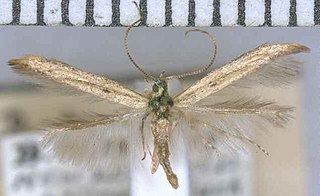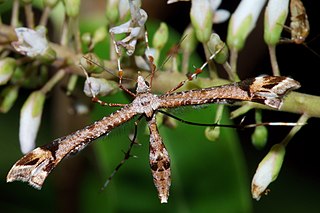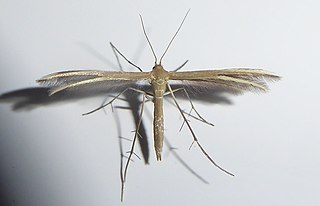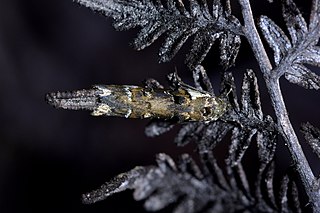
The nine-spotted moth or yellow belted burnet is a moth in the family Erebidae. The species was first described by Carl Linnaeus in his 1758 10th edition of Systema Naturae.

Tingena armigerella is a species of moth in the family Oecophoridae. T. armigerella is endemic to New Zealand where it is found in the North Island. The larvae of this species feed on plant litter. It is parasitised by the parasitic wasp Fustiserphus intrudens.

Gyrtona is a genus of moths of the family Euteliidae first described by Francis Walker in 1863.
Stictoptera is a genus of moths of the family Euteliidae erected by Achille Guenée in 1852.

Macroglossum milvus is a moth of the family Sphingidae. It is known from Réunion and Mauritius.

Batrachedra arenosella, the armoured scale eating caterpillar or the coconut moth, is a species of moth of the family Batrachedridae. It was first described by Francis Walker using specimens collected in Auckland, New Zealand. It has been hypothesised that the New Zealand moth may contain two distinct species. As well as the moth species in New Zealand, this name has been applied, perhaps incorrectly, to moths found in India, Indonesia, the Malay Peninsula, and Réunion, as well as in Australia, from the Northern Territory and northern Queensland to New South Wales and South Australia.

Amblyptilia falcatalis, the common Hebe plume moth, is a species of moth of the family Pterophoridae. This species was first described by Francis Walker and is endemic to New Zealand. This species can be found in both the North and South Islands. The larval host plants are in the Veronica genus and include Veronica stricta,Veronica salicifolia,Veronica elliptica, Veronica macrocarpa and Veronica speciosa. This moth likely has two broods a year and adults have been observed all year round.

Izatha copiosella is a moth of the family Oecophoridae. It is endemic to New Zealand, where it is found on the south-eastern parts of the North Island and throughout the South Island except the West Coast. Larvae are found in dead wood and are likely to use kōwhai species as hosts. The adults are night fliers and are attracted to light. They are on the wing in January and February.

Heterocrossa adreptella is a moth of the Carposinidae family. This species was long considered the New Zealand raspberry budmoth however this was a taxonomic misinterpretation of the type material used to describe this species. This error was corrected in 1988 with the New Zealand raspberry budmoth giving its own species name Heterocrossa rubophaga. H. adreptella is endemic to New Zealand and has been collected in the Wellington Botanic Garden and been observed resting on mānuka branches.

Pterophorus innotatalis is a moth of the family Pterophoridae. It is endemic to New Zealand and has been found in the North, South and Ruapuke Islands. Adults of this species have been recorded as being on the wing from October to March as well as in August and prefers to inhabit grass or fern covered hills. The larvae are leaf miners and feed on Dichondra species, including Dichondra brevifolia and Dichondra repens.

Mnesarchella fusilella is a species of primitive moths in the family Mnesarchaeidae. It is endemic to New Zealand and can be found in the Northland, Auckland, Waikato, Bay of Plenty, Hawke's Bay, Whanganui, and Wellington regions. It prefers well lit damp forests or moist fern-covered banks and lives at altitudes ranging from sea-level to approximately 500 m. Adults are on the wing from October to December. This species is normally day flying but males have been collected at night via light trapping.
Ericeia congressa is a moth in the family Erebidae. It is known to be found in South Africa, Madagascar, Mauritius and Réunion. It was described by Francis Walker in 1858.

Agriophara colligatella, also known as the Olearia Skeletoniser, is a moth of the family Depressariidae. It is endemic to New Zealand and is found on both the North and South Islands. This species inhabits native scrub. Larvae feed on the leaves of species in the genus Olearia during the months of November and December. They then pupate amongst the old flowers and leaves of their host plant. Adults have been observed on the wing from August to September but are most common in January. It has been hypothesised that this species overwinters as an adult as it has been observed on the wing in late autumn and early winter. Adults are attracted to light.

Amata cerbera, the heady maiden, is a moth of the subfamily Arctiinae. It was described by Carl Linnaeus in 1764. It has an extensive range in sub-Saharan Africa.
Amata simplex is a moth of the family Erebidae. It was described by Francis Walker in 1854. It is found in the Democratic Republic of the Congo and South Africa.

Gadira acerella is a moth in the family Crambidae. It was first described by Francis Walker. It is endemic to New Zealand and is found throughout the country. The species inhabits native forest from sea level up to subalpine altitudes. Larvae are assumed to feed on lichen or moss. Adults are on the wing from October until March, are active at night and are attracted to light. This species is distinctively patterned and coloured and is said to resemble a bird dropping at rest. The colouring also assists to camouflage the moth when it rests against lichen.
Culladia admigratella is a moth in the family Crambidae. It was described by Francis Walker in 1863. It has a wide range in the tropics, and has been recorded from the British Indian Ocean Territory, Kenya, Malawi, Mauritius, Nigeria, the Seychelles, Sierra Leone, Socotra, India, Myanmar, the Philippines, Sri Lanka and Sumatra.

Bityla defigurata is a moth of the family Noctuidae. It is endemic to New Zealand.

Tingena apertella is a species of moth in the family Oecophoridae. It is endemic to New Zealand and can be found in both the North and South Islands. Adults are on the wing from November to January and the species is common in beech forests at approximately 2000 ft. At rest on the ground this species appears very similar to a yellow beech leaf.

Trachypepla conspicuella is a species of moth in the family Oecophoridae. It is endemic to New Zealand and is found in both the North and South Islands. It is similar in appearance to its close relative T. euryleucota but tends to be paler. Its colouration imitates bird droppings. Larvae feed on leaf litter. Adults of this species are on the wing from November to February and have been observed resting on fences and walls.















